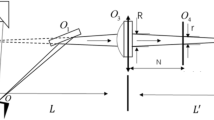Abstract
The design and fabrication processes of a novel scanner with minimized coupling motions for a high-speed atomic force microscope (AFM) were addressed. An appropriate design modification was proposed through the analyses of the dynamic characteristics of existing linear motion stages using a dynamic analysis program, Recurdyn. Because the scanning speed of each direction may differ, the linear motion stage for a high-speed scanner was designed to have different resonance frequencies for the modes, with one dominant displacement in the desired directions. This objective was achieved by using one-direction flexure mechanisms for each direction and mounting one stage for fast motion on the other stage for slow motion. This unsymmetrical configuration separated the frequencies of two vibration modes with one dominant displacement in each desired direction, and hence suppressed the coupling between motions in two directions. A pair of actuators was used for each axis to decrease the crosstalk between the two motions and give a sufficient force to actuate the slow motion stage, which carried the fast motion stage. A lossy material, such as grease, was inserted into the flexure hinge to suppress vibration problems that occurred when using an input triangular waveform. With these design modifications and the vibration suppression method, a novel scanner with a scanning speed greater than 20 Hz is achieved.
Similar content being viewed by others
References
SPANNER K, VOMDRAN S. Advances in piezo-nanopositioning technology [C]// Proceedings of IEEE/ASME Conference on Advanced Intelligent Mechatronics. Kobe, Japan, 2003: 1338–1343.
SCHITTER G, STEMMER A. Model-based signal conditioning for high-speed atomic force and friction force microscopy [J]. Microelectro Eng, 2003, 67/68: 938–944.
GEORG S, PHILIOPP J T, PAUL K H. Design and input-shaping control of a novel scanner for high-speed atomic force microscopy[J]. Mechatronics, 2008, 18: 282–288.
GEORG E, GEORG S, JOHANNES H, TZVETAN I, KATARINA I, ROH P, NIELS H, JONATHAN A, PHILIPP T, IVO W, PAUL K. Components for high speed atomic force microscopy[J]. Ultramicroscopy, 2006, 106: 881–887.
KWON J, HONG J, KIM Y, LEE D, LEE K, LEE S, PARK S. Atomic force microscope with improved scan accuracy, scan speed, and optical vision[J]. Rev Sci Instrum, 2003, 74: 4378–4383.
LEE D, Kwon D. Development of a two-axis flexure-guided nano-stage [C]// Proceeding of Korean Society of Mechanical Engineers. Pyeongchang, Korea, 2008: 13–18.
KWON G, KIM S, JEONG M, HAN S, CHOI C, HAN S, HONG J, LEE H. High-speed atomic force microscope lithography using a piezo tube scanner driven by a sinusoidal waveform[J]. Ultramicroscopy, 2009, 109: 1052–1055.
TOSHIO A, NORIYUKI K, DAISUKE M, EISUKE T, KIWAMU S, AKITOSHI T. A high-speed atomic force microscope for studying biological macromolecules in action[J]. ChemPhysChem, 2003, 4: 1196–1202.
ANDO Y. Development of three-dimensional electrostatic stages for scanning probe microscope[J]. Sensors and Actuators A: Physical, 2004, 114: 285–291.
SALAPAKA S, SEBASTIAN A, CLEVELAND J P, SALAPAKA M V. High bandwidth nano-positioner: A robust control approach [J]. Rev Sci Instrum, 2002, 73: 3232–3241.
DONG W, SUN L N, DU Z J. Design of a precision compliant parallel positioner driven by dual piezoelectric actuators [J]. Sensors and Actuators A: Physical, 2007, 135: 250–256.
YANLING T, BIJAN S, DAWEI Z, GURSEL A. Development and dynamic modelling of a flexure-based Scott-Russell mechanism for nano-manipulation [J]. Mechanical Systems and Signal Processing, 2009, 23: 957–978.
WOODY S C, SMITH S T. Performance comparison and modeling of PZN, PMN, and PZT stacked actuators in a levered flexure mechanism [J]. Rev Sci Instrum, 2004, 75: 842–848.
SMITH S T. Flexures Elements of Elastic Mechanism Design [M]. Amsterdam: Gordon and Breach, 2002: 48–52.
ODEN J T, RIPPERGER E A. Mechanics of Elastic Structures[M]. 2nd ed. New York: McGraw-Hill, 1968: 35–55.
Author information
Authors and Affiliations
Corresponding author
Additional information
Foundation item: Work(R0A-2007-000-20042-0) partly supported by the Second Stage of Brain Korea 21 Projects, and partly by the Korea Science and Engineering Foundation (KOSEF) through the National Research Laboratory Program funded by the Ministry of Science and Technology of Korea
Rights and permissions
About this article
Cite this article
Park, Jk., Moon, Wk. Development of XY scanner with minimized coupling motions for high-speed atomic force microscope. J. Cent. South Univ. Technol. 18, 697–703 (2011). https://doi.org/10.1007/s11771-011-0750-2
Received:
Accepted:
Published:
Issue Date:
DOI: https://doi.org/10.1007/s11771-011-0750-2




